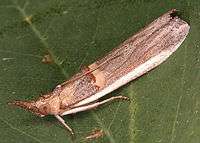Etiella zinckenella
| Etiella zinckenella | |
|---|---|
 | |
| Scientific classification | |
| Kingdom: | Animalia |
| Phylum: | Arthropoda |
| Class: | Insecta |
| Order: | Lepidoptera |
| Family: | Pyralidae |
| Genus: | Etiella |
| Species: | E. zinckenella |
| Binomial name | |
| Etiella zinckenella (Treitschke, 1832)[1] | |
| Synonyms | |
| |
Etiella zinckenella, the pulse pod borer moth, is a moth of the family Pyralidae. It is found in southern and eastern Europe[2] and in the tropics and subtropics of Africa and Asia. They have also been introduced to North America and Australia.[3] It is usually a minor pest for many legumes, but can be a serious pest.


Caterpillar
The wingspan is 22–26 mm.
Ecology
The caterpillars feed on the mung bean, Phaseolus lunatus and other species of Fabaceae such as pigeonpea, cowpea, lablab, soybean, peas, chickpea, horse gram, green and black grams, Crotalaria juncea, C. micans, C. saltiana, Lathyrus sativus, and Vigna unguiculata.[4] They have also been recorded on Catha edulis (Celastraceae).[5]
References
- ↑ "GlobIZ search". Global Information System on Pyraloidea. Retrieved 2011-09-29.
- ↑ UKMoths
- ↑ www.agroatlas.ru
- ↑ "Etiella zinckenella (Treitschke)". ICAR-National Bureau of Agricultural Insect Resources. Retrieved 11 March 2017.
- ↑ (in French) van der Vossen, H.A.M., 2002. Catha edulis (Vahl) Forssk. ex Endl. [Internet] Fiche de PROTA4U. Oyen, L.P.A. & Lemmens, R.H.M.J. (Editeurs). PROTA (Plant Resources of Tropical Africa / Ressources végétales de l’Afrique tropicale)
| Wikimedia Commons has media related to Etiella zinckenella. |
This article is issued from
Wikipedia.
The text is licensed under Creative Commons - Attribution - Sharealike.
Additional terms may apply for the media files.